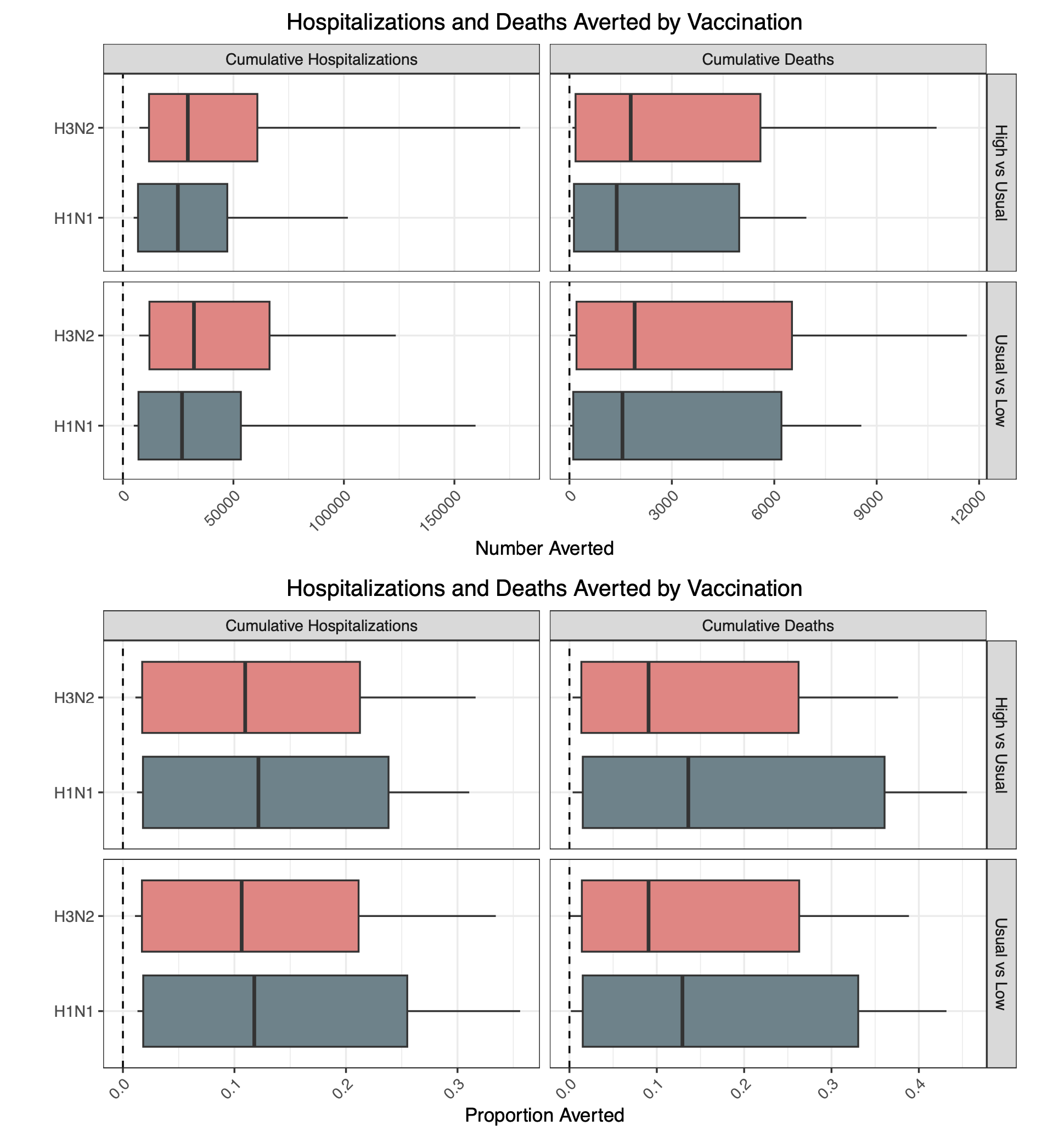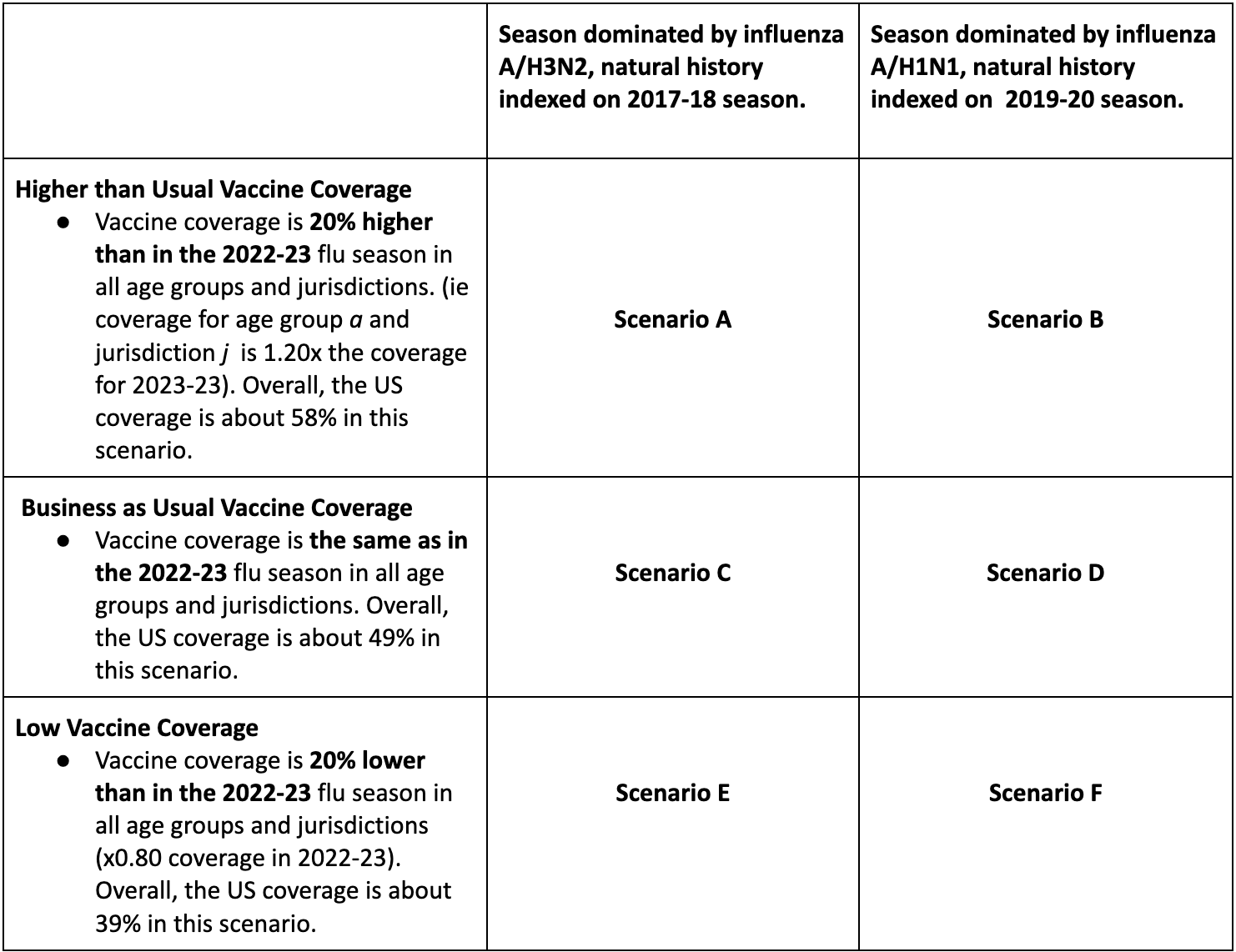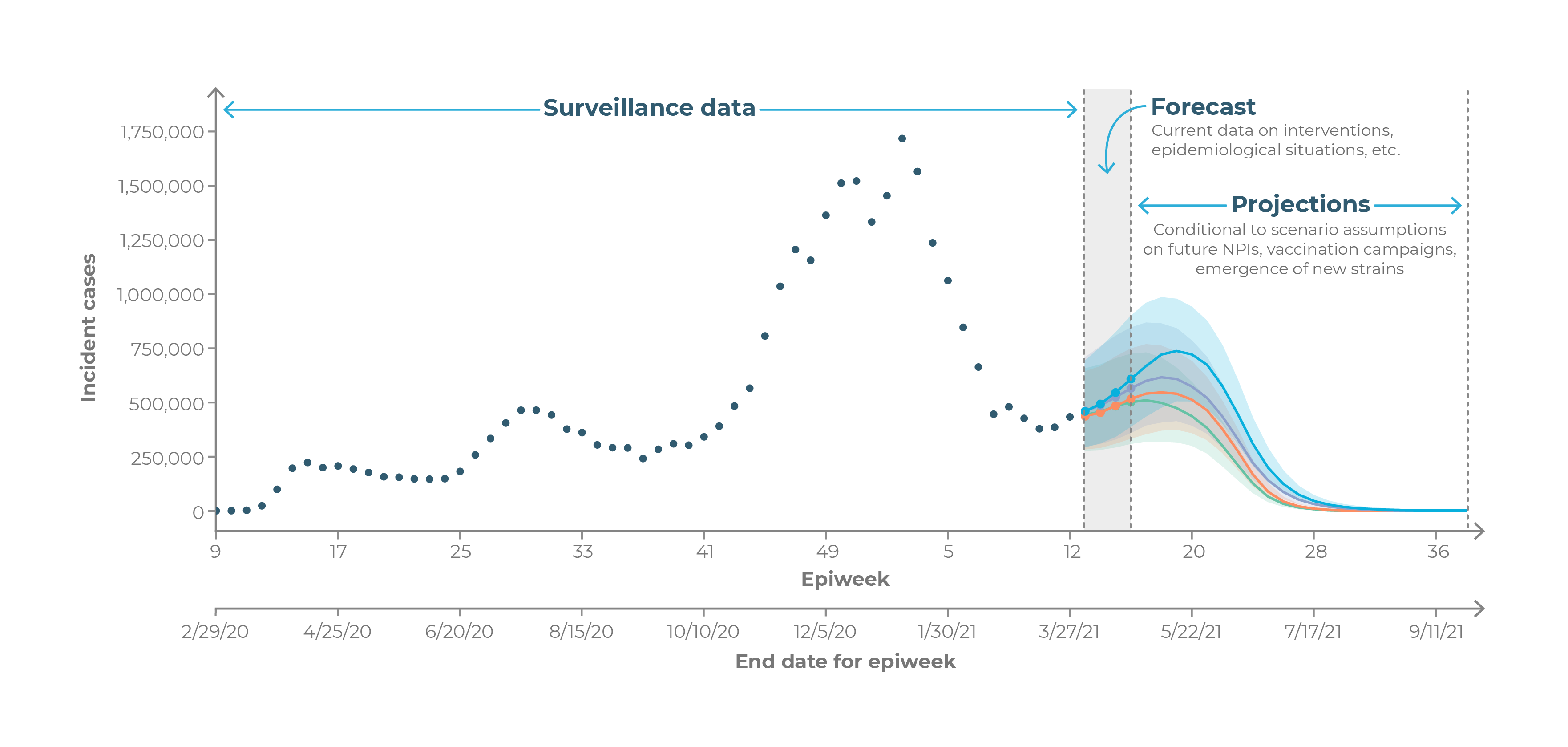Flu
Scenario Modeling Hub
A Note on Scenario Modeling Hub Round 1 of 2024-2025 (October 4, 2024)
In the first influenza round of the 2024-25 season, the Scenario Modeling Hub generated pre-season projections for the 43-week period from Sunday, Aug 11, 2024 to Saturday, June 7, 2025. We considered 6 scenarios representing the impact of 3 levels of vaccine coverage (20% higher than in the 2022-23 reference season, similar to the reference season, and 20% lower than the reference season), combined with the dominance of the influenza A/H3N2 or A/H1N1 subtype. Ensemble projections are based on contributions from 9 teams (including 8 contributing national projections) using the trimmed linear opinion pool approach.
Our main findings include:
- The dominant subtype will more heavily drive the hospitalization and death burden this influenza season than vaccination: we project an A/H3N2-dominant season would have moderate to high burden of disease compared to a low to moderate burden from a A/H1N1-dominant season, compared to influenza epidemics in the past decade.
-
Vaccination could substantially modify hospitalization
and death burden:
- A 20% relative increase in vaccine coverage compared to usual (58% vs 49% vaccination coverage) would reduce influenza-related hospitalizations by 11% (95% PI: 1-18%; H3N2 scenario) or 12% (2-22%; H1N1 scenario).
- A 20% relative drop in vaccine coverage compared to usual (49% vs 39%) would generate 11-12% increases in influenza-related hospitalizations. In absolute terms, this represents differences in the order of 25,000 to 32,000 hospitalizations (range across medians).
- Projected percent changes in deaths range between 9-14% for a 20% change in vaccine coverage, depending on the scenario, corresponding to differences of 1,400-1,900 influenza-related deaths.
- Median weekly hospitalizations are projected to peak between 18,500 (95% PI: 3,100-54,600) and 37,000 (95% PI: 11,200-101,600), depending on the scenario (most optimistic, scenario B, high vaccine coverage, A/H1N1 dominance vs. most pessimistic, scenario E, low vaccine coverage, H3N2 dominance).
- Cumulative hospitalizations for this season are projected to reach between 223,000 (95% PI: 111,000-443,000) and 395,000 (95% PI: 202,000-836,000), depending on the scenario.
- Cumulative influenza deaths are projected to reach between 24,600 (95% PI: 3,400-34,900) and 42,900 (95% PI: 7,400-96,200), depending on scenario.
- In all scenarios, ensemble projections suggest a prolonged period of high influenza activity between December and February, in part due to differences in projected peak timing across models. Periods of high influenza activity tend to occur earlier in A/H3N2 projections while A/H1N1 projections have more protracted activity lasting into the Spring.
- The combined impact of influenza and COVID-19 on hospitalizations is projected to remain similar to that of last season (2023-24), irrespective of the flu scenario (based on 50% projection intervals). These estimates are based on the assumption of high immune escape for COVID-19, and moderate COVID-19 booster uptake in all age groups (Round 18 scenario A, https://covid19scenariomodelinghub.org/ ).
- There is considerable variability between models as regards projected timing and severity of epidemics, in part due to differences in underlying assumptions regarding seasonality and seeding. This variability is compounded by the absence of early season influenza calibration data.
-
A few caveats are worth noting:
- These are pre-season projections, and hence there is no calibration data on the dynamics of the upcoming epidemic. Further, the NHSN hospitalization dataset was paused in May 2024 so that no recent calibration data was available to the teams.
- Reporting to the NHSN hospitalization dataset is expected to fully resume in November 2024 and may not perfectly mirror prior NHSN data. Hence, there will be no observational data to compare to these influenza projections for September-October 2024, and any change to reporting propensity under the new reporting rules or to influenza testing practices in 2024-25 would affect comparison of our hospitalization projections to data.
- We assumed a fixed VE of 40% against medically attended illnesses in all flu scenarios, which anticipates a good match between circulating viruses and vaccine strains. Assumptions regarding the effects of the vaccine on infection and onward transmission were left at teams’ discretion.
Fig 1. Hospitalizations and deaths averted by vaccination for H3N2 and H1N1 scenarios. Estimates averted by contrasting cumulative projections at the end of the season for high vs usual vaccine coverage scenarios (top) and usual vs low vaccine assumptions (bottom), for hospitalizations (left) and deaths (right). Estimates are pair-wise ensemble estimates.

Table 1. Flu Scenario Modeling Hub round 1 2024-2025 scenarios. More detailed scenario definitions and model characteristics can be found at https://github.com/midas-network/flu-scenario-modeling-hub.

Rationale
Even the best models of emerging infections struggle to give accurate forecasts at time scales greater than 3-4 weeks due to unpredictable drivers such as a changing policy environment, behavior change, the development of new control measures, and stochastic events. However, policy decisions around the course of emerging infections often require projections in the time frame of months. The goal of long-term projections is to compare outbreak trajectories under different scenarios, as opposed to offering a specific, unconditional estimate of what “will” happen.

As such, long-term projections can guide longer-term decision-making while short-term forecasts are more useful for situational awareness and guiding immediate response.

